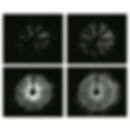



High-Pulse-Rate Pulsed Inductive Thruster (HiPeR-PIT)

Sponsor: NASA Marshall Spaceflight Center
Personnel: Curtis Promislow, Arvindh Sharma, Justin Little (PI)
Inductive pulsed plasma thrusters (IPPTs) are a class of electric propulsion (EP) device that accelerate plasma via the interaction of self-generated electromagnetic fields with those arising from currents induced in the plasma. The High Pulse Rate Pulsed Inductive Thruster (HiPeR-PIT) is a compact multi-kilowatt class planar IPPT designed to operate at high repetition rates (1kHz - 10kHz) with steady propellant injection. This mode of operation has been theorized to result in high thruster efficiency while also eliminating performance and lifetime limiting high speed pulse valves. The HiPeR-PIT research effort consists of two related branches: 1) The study of gas breakdown, inductive energy coupling, and current sheet formation and stability at the low per-pulse discharge energies characteristic of high repetition rate IPPTs and 2) the development of a power processing unit (PPU) for enabling operation at the required high repetition rates.


Adaptive-field Central-cathode Magnetically-shielded Electric (ACME) Thruster

Sponsor: TBA
Personnel: P. Thoreau, J. Little (PI)
The erosion of ceramic channel insulators in Hall thrusters has been the most dominant cause of end-of-life since the first Hall thrusters first flew in 1971. Recent developments in magnetic shielding, a new magnetic field geometry where field lines are tangential to the insulator at the front of the thruster, have reduced channel erosion to negligible levels. However, the switch to a magnetically shielded configuration significantly increases plume divergence and creates complex optimizations of the field geometry. The ACME thruster has adjustable pole, anode, and cathode positioning to allow for significant changes while maintaining the shielded shape. Because the channel wall, magnet, insulators, and Hiperco magnetic circuit of each pole all move together, the shape of the shielding on each of the poles remains consistent. The influence of the inner magnetic pole position on thruster performance has been investigated with Faraday probe, retarding potential analyzer, and thrust stand measurements. The relative pole positions, and therefore field angle in the channel, significantly influences the plume divergence and thrust measured. Significant changes to the mass, current, and voltage utilization efficiencies suggest it has a strong impact on the fundamental behavior of the discharge plasma. This is further supported by the discharge current oscillations, which exhibit a dependence of the breathing mode frequency and amplitude on pole position. These relations are further complicated as certain pole positions are more prone to discharge mode transitions




Non-Equilibrium Plasma Chemistry in Molecular-Propellant Electric Propulsion

Sponsor: TBA
Personnel: Landon Bevier, Justin Little (PI)
UW SPACE Lab is researching electric propulsion thrusters operating on alternative propellants. Traditionally, Ion and Hall thrusters operate on Xenon and Krypton since they are non-reacting however other propellants possess many advantages. While molecular propellants exhibit complex plasma chemistry, they are appealing due to their high-density storage, in situ resource utilization, lower propellant cost, and/or possibility for multi-mode propulsion systems. We are researching how to exploit these benefits while still providing necessary thruster performance. A control volume model incorporating chemical kinetics has been developed for water vapor as well as Nitrous Oxide in order to predict plasma composition and thruster performance. Experimental investigation of molecular propellants is on-going with the use of an electron cyclotron resonance thruster and a helicon plasma source.




Scaling, Feasibility, and Mission Design for Plasma Aerocapture

Sponsor: NASA
Personnel: Charlie Kelly, Justin Little (PI)
Aerocapture is an orbital maneuver in which a spacecraft uses atmospheric drag to transfer from an escape trajectory to a stable orbit around a planet. This research focuses on the use of a magnetic dipole plasma to ionize, absorb, and deflect atmospheric flow, generating the requisite drag force without the need for large mechanical structures or high propellant mass. The physics of this device, called a magnetoshell, are not well understood. SPACE Lab is developing analytic models to simulate the magnetoshell/atmosphere interaction so that the performance and physical scaling can be characterized. A novel experimental technique using a hypersonic neutral flow tool is also being used to validate modeling and demonstrate magnetoshell performance.
